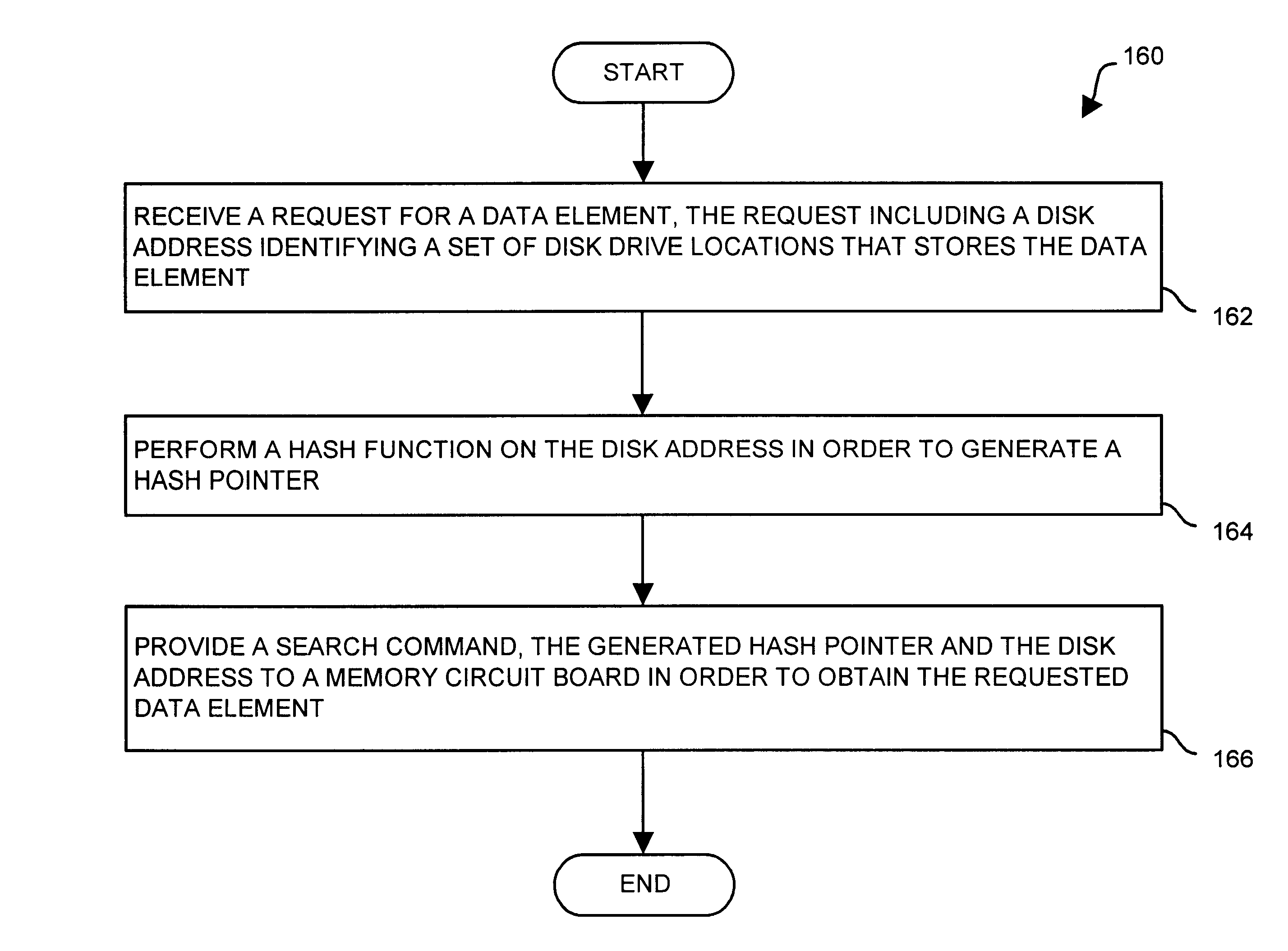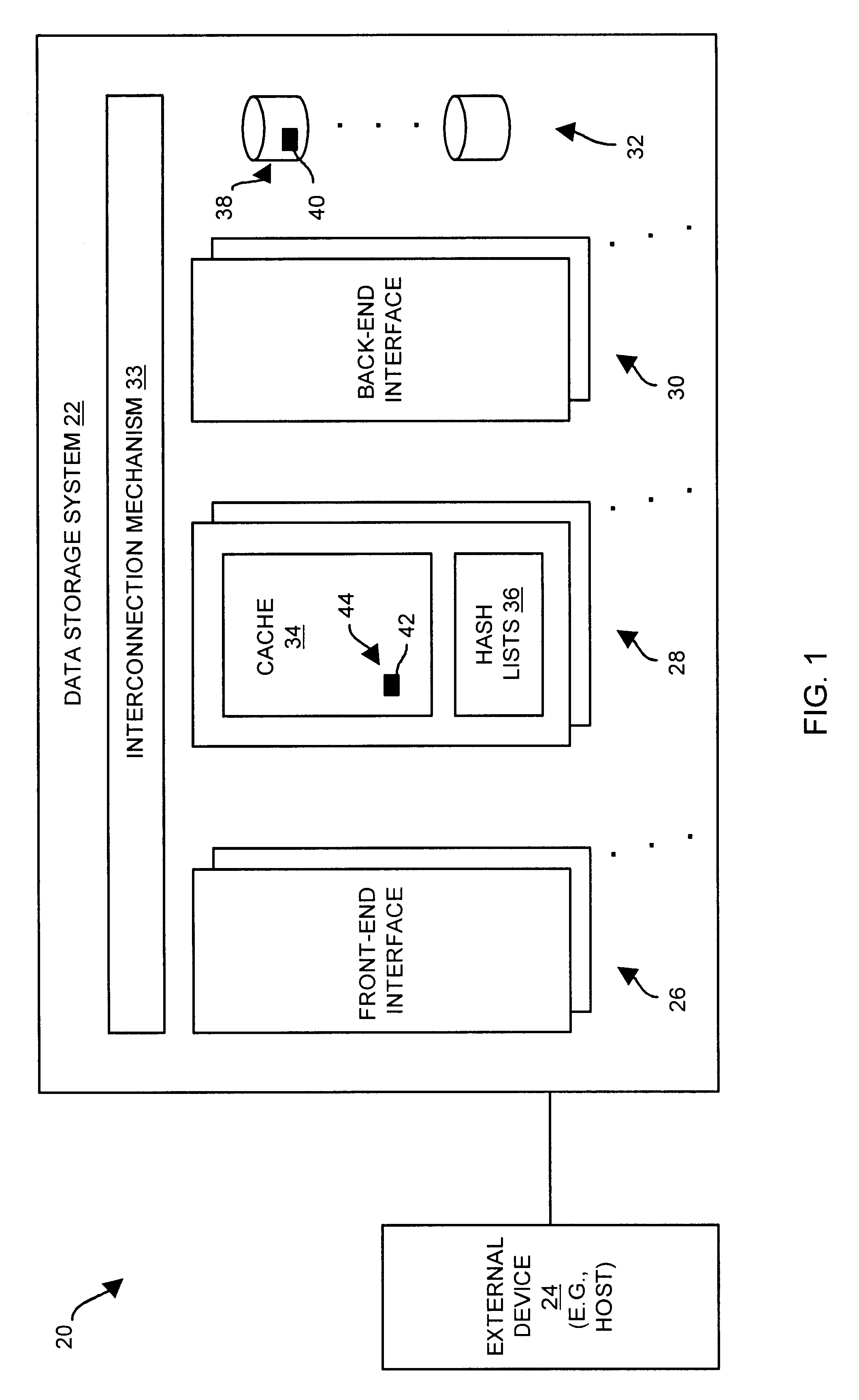[0008]In contrast to the above-described conventional track table approach and the alternative single
list of entries approach, embodiments of the invention are directed to techniques for accessing data elements (e.g., blocks of data) using a set of hash lists. The use of the set of hash lists alleviates the need for a track table that scales with the size of the set of disk drives as in the above-described track table approach, and requires less time to determine whether data blocks can be accessed from the cache compared to the above-described single list of entries approach. Furthermore, operations which access the set of hash lists can be performed within a set of memory circuit boards that stores the set of hash lists rather than another circuit board (e.g., a front-end interface circuit board) in order to, among other things, (i) provide superior performance, (ii) free the other circuit board to perform other tasks, and (iii) reduce traffic and associated latencies in the
interconnection mechanism between the set of memory circuit boards and the other circuit board.
[0009]One embodiment is directed to a data storage
system having a set of disk drives to store a data element, a set of memory circuit boards to store a set of hash lists and a cache, and a front-end interface coupled to the set of disk drives and the set of memory circuit boards. The front-end interface is configured to (i) receive a request for the data element, the request including a disk address identifying a set of disk drive locations that stores the data element, (ii) perform a
hash function on the disk address in order to generate a hash pointer, and (iii) provide a search command, the disk address and the generated hash pointer to the set of memory circuit boards. The set of memory circuit boards is configured to (i) receive the search command, the disk address, and the hash pointer from the front-end interface, (ii) search the set of hash lists based on the hash pointer and the disk address, and (iii) provide an indication to the front-end interface indicating whether the set of hash lists includes an entry indicating that the data element resides in cache. The use of the
hash function enables each
hash list (i) to remain relatively short and (ii) to include caching information relating to only a portion of the cache. As such, a determination as to whether a data element resides in the cache can be made by simply searching one of the hash lists for quick
response time. Furthermore, the burden of searching the
hash list is on the set of memory circuit boards thus freeing both the front-end interface (e.g., to perform other operations) as well as the communications mechanism connecting the front-end interface with the set of memory circuit boards.
[0010]In one arrangement, the set of memory circuit boards is configured to search the set of hash lists by (i) selecting a hash list from the set of hash lists based on the hash pointer, each hash list including a set of entries, each entry including a disk address field; and (ii) determining whether the disk address of the request for the data element matches contents of the disk address field of an entry of the selected hash list in order to ascertain whether the set of hash lists includes an entry indicating that the cache stores the data element. The set of hash lists includes an entry indicating that the cache stores the data element when the disk address matches contents of the disk address field of an entry of the selected hash list. The set of hash lists does not include an entry indicating that the cache stores the data element when the disk address does not match contents of the disk address field of any entry of the selected hash list. Accordingly, the set of memory circuit boards does not need to search every entry in the set of hash lists, but only entries in the selected hash list until it finds an entry indicating that the cache stores the data element, or until it has searched the entire selected hash list (and has determined that the data element is not available in the cache) thus providing an acceptable
response time.
[0011]In one arrangement, a second disk address identifies caching of a second data element. In this arrangement, the front-end interface circuit board is further configured to perform the hash function on the second disk address in order to generate a second hash pointer. Additionally, the set of memory circuit boards is further configured to add, to the set of hash lists, a second entry based on the generated second hash pointer and the second disk address. The second entry identifies the second data element. Accordingly, the set of memory circuit boards (rather than the front-end interface) can add entries to the set of hash lists thus freeing the front-end interface to perform other operations.
[0012]In one arrangement, the set of memory circuit boards is configured to add the second entry by selecting a hash list of the set of hash lists based on the second hash pointer, and attaching the second entry to the selected hash list. Preferably, the selected hash list is a
linked list data structure, and one of the set of memory circuit boards is configured to attach the second entry by placing the second entry at a head of the
linked list data structure. Placing the second entry at the head rather than the
tail can simply involving inserting the second entry in front of the original head and avoid having to
traverse the entire hash list. Furthermore, the oldest entry is at the
tail and the newest entry is at the head thus enabling the data storage system to easily know which entries are the newest and oldest. For example, the set of memory circuit boards can be further configured to determine a number of entries in the selected hash list, and delete a third entry from the
tail of the
linked list data structure, i.e., selected hash list, when the number of entries in the selected hash list is greater than a predetermined limit. Accordingly, when selected hash list becomes excessively long, the least recently used entry can be removed from the selected hash list in order to conserve or limit the amount of memory space used by the hash list.
 Login to View More
Login to View More  Login to View More
Login to View More 


